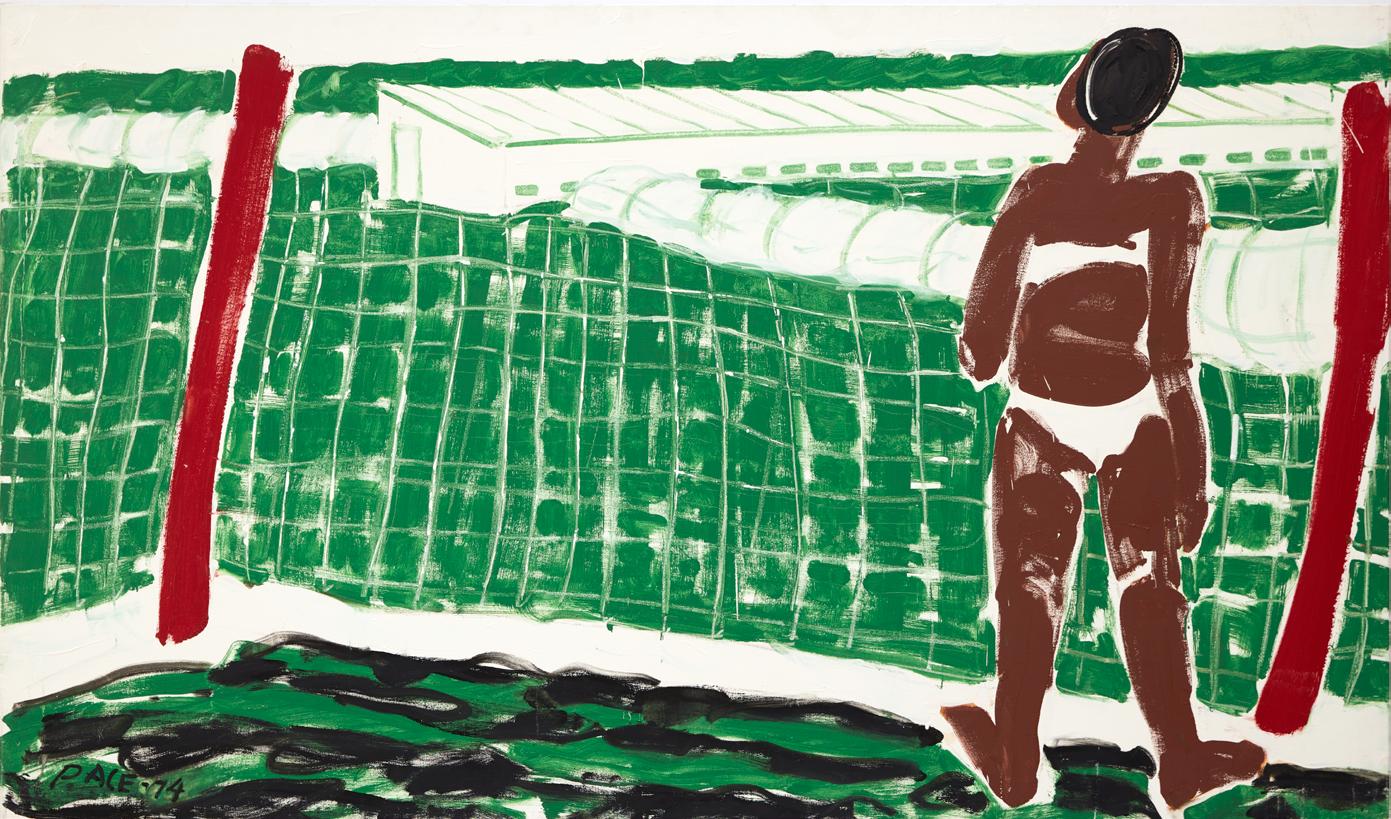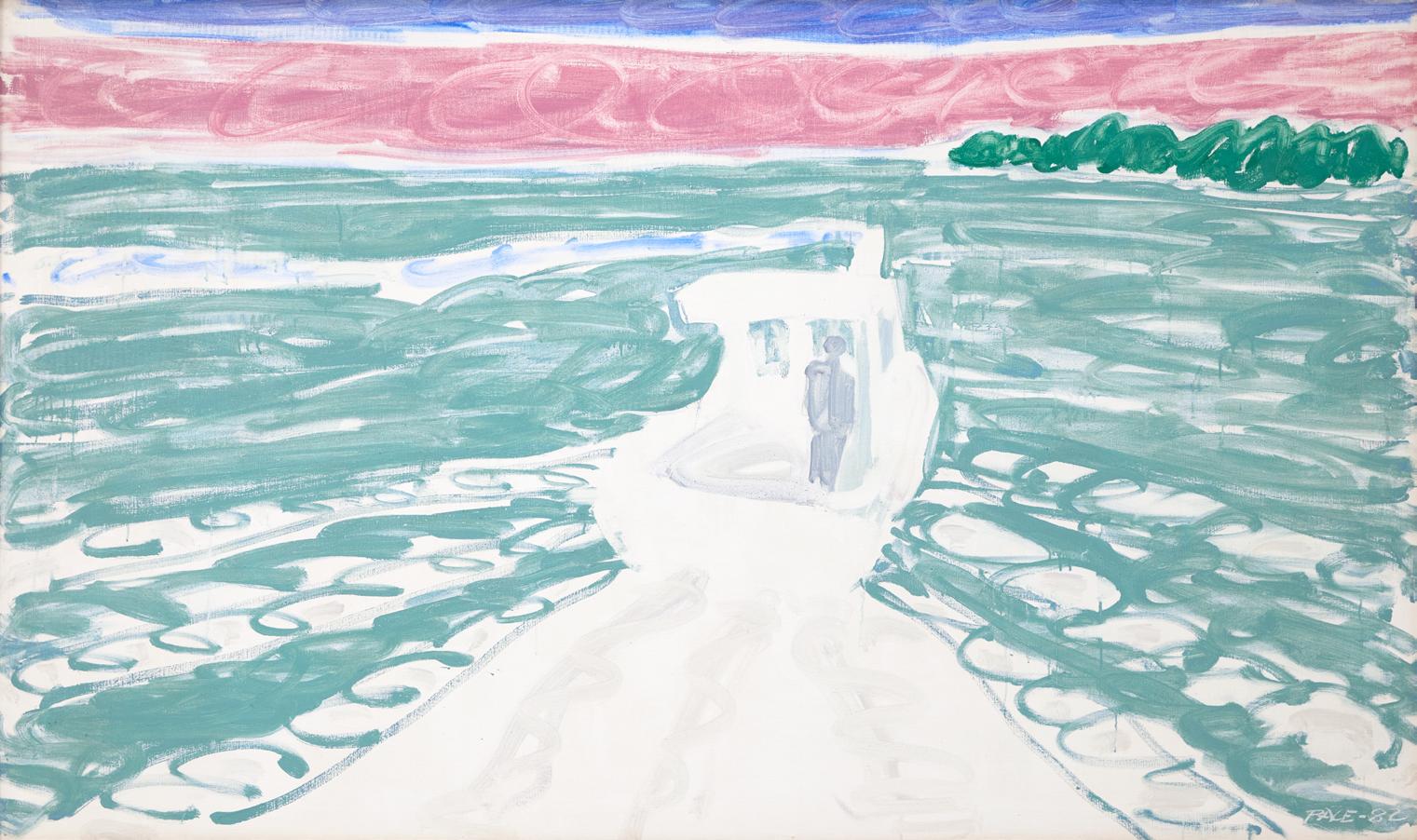

Stephen Pace: A Lifetime in Paint
by CARL LITTLE
Visiting Stephen Pace at his home and studio in Stonington in September 2004, I wondered at the 86-year-old painter’s compelling spirit—full of paint and vinegar if you will. From humble beginnings in the Midwest to the artistic hotbed of Abstract Expressionism in New York City to the working waterfront of his Maine home, this artist carried a lifetime’s worth of commitment to paint.
That drive to activate the senses through oil and watercolor comes through in the paintings in this show. The work spans more than a half century, from a 1948 watercolor that may be a portrait of Pace’s friend and mentor Milton Avery to a bold and bright rendering of five sunflowers and three blue jays painted in 2004. In between we encounter prime examples of his ab-ex canvases, a number of his favorite Maine motifs, and the figure—and horses—he brought to life time and again.
Pace met Avery in Mexico, at the Institute of Fine Arts in San Miguel Allende, Mexico, in 1947. He had ventured there not long after serving in World War II, drawn by the promise of creative energy. Avery’s unconventional palette inspired the artist to shift from more traditional realms into abstract idioms.
Moving to New York City after an East Coast/West Coast flip of the coin in a New Orleans bus station, Pace dove into the heady world of the Abstract Expressionists. With the guidance of Hans Hoffman and others, he developed a charged approach to the canvas, one that gained him acclaim in the art world. As critic Thomas Hess put it in 1961, Pace was a “brilliant member of the second generation of New York School painters that burst on the scene, in the early 1950s, fully made, as if from the forehead of the Statue of Liberty.”
The oils and watercolors in the show dating from the 1950s and early ‘60s epitomize Pace’s powers with paint. These untitled works are aggressive as he lashed the oil across the surface. They can be searing but also moody—and always dynamic.
In his transition to more representational modes, Pace maintained the energy of his action paintings. Daring in his choice of colors—some of his bodies are orange—he painted reclining female figures with a fresh and vital hand. Even several domestic scenes of a woman holding a black cat radiate a special energy.
Pace’s Self Portrait, Stonington, 72-5, 1972, is at once formal—the painter wears a suit and hat—and unceremonious. Framed within a crooked window before a glowing landscape, the figure standing on a porch puts pen to white paper. I like to think he is signing the deed to the house he and his wife Palmina purchased the next year and which they later donated to the Maine College of Art.
Just as they had done for John Marin, the Zorachs, Alfred Chadbourn, Jill Hoy, Jon Imber and a host of other eminent painters, Pace’s Stonington surroundings spurred him to take up the brush. West View from Green Head, 1981, and White Sun at Sun Beach, 1982, highlight his sense of place, the islands and coastline delivered with singular panache.
The town’s working waterfront was a constant source of subjects. As someone who had picked cotton as a youngster, Pace understood the toil of the lobster fishers and paid tribute to their enterprise. The watercolor Pulling Traps, 1975, documents the lobsterman’s ability to haul and steer at the same time. In Lobster Boat at Dawn, 1982, a fishing vessel cuts through the water headed out for a morning of hauling.
In Richard Kane’s 2008 documentary Stephen Pace: Maine Master, art historian Martica Sawin remarks on how sparing the artist is with his color and brushstrokes, which are made “with judgment” as if he were saying, “make this count.” His horse paintings, inspired by memories of his childhood on a subsistence farm in Missouri and by visits to Chincoteague Island in North Carolina, are built from such economical dashes of paint, the powerful creatures galloping across the picture plane or headlong toward the viewer.
The soundtrack to Kane’s documentary consists of jazz pieces. It’s a perfect fit: Pace was an improviser, each painting an opportunity to lay down another riff. Consider the oil Pink Nude with Blue Cat, 1963, or the
watercolor October Blueberry Fields #2, 1989: both paintings astonish the eye in their color choice and freeform composition.
In the end, Pace was one of those natural painters “whose every moment,” in the words of art critic Dore Ashton, “is devoted solely to the art of painting and whose psyches were never undermined by excessive theorizing.” He made art out of joy, relishing that time in the studio when his thoughts—and brush—turned to the wonders of a wide and exhilarating world. •
Art critic, freelance writer, and poet Carl Little lives on Mount Desert Island in Somesville, Maine. He is a noted writer and lecturer on the art and artists of Maine.
Stephen Pace: Oils














Stephen Pace: Watercolors









Reflection, 1976, watercolor on paper, 22 x 15 in.








Blue Wall, 1980, watercolor on paper, 22 1/4 in.



, 1984, watercolor on paper, 9 3/4 x 13 1/4 in.




in Fog, 1993, watercolor on paper, 17 3/4 x 27 in.



Stephen Pace
(1918-2010)
Throughout his long and productive career, Stephen Pace made significant contributions to American painting as a prominent member of the New York School, known for his forceful abstract expressionist paintings and later luminous representational paintings and watercolors, which were inspired in large part by his home and surroundings in Stonington, Maine.
Born in Charleston, Missouri, Pace began his art studies at age 17 with WPA artist Robert Lahr in Evansville, Indiana. After serving in World War II, he continued his studies on the GI Bill at the Instituto Allende in San Miguel de Allende, Mexico, where he met Milton Avery, who became a lifelong friend and mentor. On the advice of Avery, Pace moved to New York City to study at the Art Students League and independently with noted artist and teacher Hans Hofmann.
In 1953, Pace made his first trip to Maine, traveling down the coast to the small fishing village of Stonington on Deer Isle, which would become his longtime summer home. In 2007, Pace bequeathed his house and studio in Stonington to the Maine College of Art & Design as an artist residency to ensure its continued use as an artistic haven and inspiration for future generations.
Celebrated for his radiant use of color and agility in distilling the essence of a subject in succinct and telling strokes, Stephen Pace’s work has been the subject of over 85 solo exhibitions at galleries and museums throughout the United States. It is represented in over 50 museum collections, and the subject of the monograph Stephen Pace (Hudson Hills, 2004), with text by art historian Martica Sawin.
